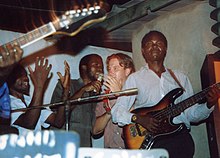Music of Zimbabwe
James Chimombe, whose romantic ballads and the influential sungura guitar melody (consisting of lead, rhythm and bass), made him a favorite in the late 80s.Other notable artists include Zexie Manatsa, Tinei Chikupo, Paul Matavire, Zvishavane Sounds and Jonah Moyo's Devera Ngwena, among others.The 90s decade was dominated by musicians such as Leonard Dembo, the effervescent Khiama Boys, veteran Simon Chimbetu and then upcoming artistes Alick Macheso, Tongai Moyo and Somandla Ndebele.Having dominated sales, tour and concert attendances, the heckling and counter-heckling by the artists at shows and in some recorded material is strong proof of their feud akin to the BIG vs Tupac in American '90s hip hop.Alick Macheso has largely dominated the scene, creating popular dance choreographies such as 'Borrowdale', Razor Wire, zoraaa butter, femba bute and kedebu, which mimic everyday routines in Zimbabwean life.System Tazvida, Simon Chimbetu, James Chimombe, Tongai Moyo, Paul Matavire, John Chibadura, Leonard Dembo, and Thomas Makion have all died.[8] This genre consisted of male singers in an acapella style, which differed from most of the typical music at the time that was formed around unique instruments.One can also trace similarities from Kwela, a pennywhistle-based, street music from the southern part of Africa with jazzy underpinnings and a distinctive, skiffle-like beat.It is also closely related to Marabi which was the name given to a keyboard style (often using cheap pedal organs) that had a musical link to American jazz, ragtime and blues, with roots deep in the African tradition.Gospel artists who emerged from the mid nineties include Pastor Haisa (Lawrence Haisa), Brother Sam with his hits "Makanaka Jesu" and "Cherechedza", Elias Musakwa, Rita Shonhiwa, The Gospel Trumpet of the "Rose Of Sharon" fame and Shingisai Suluma who only became popular in the early 21st century with the hit song "Mirira Mangwanani"; though she first recorded in the nineties.[2][14] Classified by musicologists as a lamellaphone, part of the plucked idiophone family, it is created from things found in nature such as a wooden board (often fitted with a resonator) and tines.[16] Though musicologist Hugh Tracey believed the mbira to be nearing extinction in the 1930s, the instrument has been revived since the 60s and 70s, and has gained an international following through the world music scene.Thomas Mapfumo is widely credited with popularizing his genre of Chimurenga music, which includes guitar, drums, Western-style vocals, and mbira in the same band.A brand of Jazz was created in Bulawayo, in the 1940s and 1950s, and was made popular by August Musarurwa with his African Dance Band of the Cold Storage Commission of Southern Rhodesia.His lyrics were mostly centered on love and relationships, with songs like Anodyiwa Haataure, Ukarambwa Usachema, Vanotipedzera Mashoko and Dai Hanzvadzi Yairoorwa, with which he achieved popularity.With the emergence of the Urban Grooves-style, the content of lyrics shifted to more closely resemble that of American RnB, Hip Hop and Pop music.Artists such as Sanii Makhalima, Alexio Kawara, Roy and Royce, David Chifunyise, Leonard Mapfumo, Roki, Stach, Betty Makaya, Extra Large, Maskiri, Kactus and Nehoreka laid the groundwork for the new genre, which gained increasing popularity among the youth.The style was helped by the 100% local content policy in effect at the time, which required all radio stations to play only music by Zimbabwean artists.







Ngoma drumsMberengwamarimbasZimbabweansRhodesiaBira ceremonyprotest songsDigvijay BhonsaleSimon ChimbetuSystem TazvidaAlick MachesoJames ChimombeLeonard DemboTongai MoyoLeonard ZhakataMbube, the related South African vocal musicFour BrothersJohn PeelThe Bhundu BoysZimbabwean jazzpennywhistleMarabiAugust MusarurwaSkokiaanPrince Kudakwashe MusarurwaOliver MtukudziChimurenga musicThomas MapfumoShona languageRhodesianIan SmithRobert MugabeTuku MtukudziPaul Matavire'sNurembergGermanyZimdancehalldancehallWinky DSoul Jah loveAfrican RumbaDemocratic Republic of the CongoThe R.U.N.N. familyJonathan WutawunasheMechanic ManyerukeCarol MujokoroBrother SamShingisai SulumaCharles CharambaSunguraTembalamia cappellamusicologistslamellaphoneidiophoneresonatorcalabashindigenousmbira musiccolonialismHugh Traceyworld musicDumisani MaraireEphat MujuruStella ChiwesheChartwell DutiroMbuya DyokoCosmas MagayaForward KwendaChiwoniso MaraireChris BerryMozambiquehip-hopShabazz PalacesmarimbaZambiaNdebeleBulawayoDorothy MasukaLovemore MajaivanaSandra NdebeleVusa MkhayaAfro-fusion bandLouis MhlangaJohn ChibaduraSteve MakoniBhundu BoysChimurengaZANU-PFChazezesa ChallengersEminemZimbabwean hip hopRoy and RoyceLeonard MapfumoMaskiriMokoombaPaul BerlinerInternational Library of African MusicMakwayeraShona musicList of Zimbabwean musiciansEyre, BanningBanning EyreBerkeleyMusic of Africa AlgeriaAngolaBotswanaBurkina FasoBurundiCameroonCape VerdeCentral African RepublicComorosRepublic of the CongoDjiboutiEquatorial GuineaEritreaEswatiniEthiopiaThe GambiaGuineaGuinea-BissauIvory CoastLesothoLiberia
